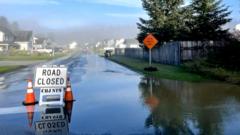As residents of Juneau, Alaska, brace for potential catastrophic flooding, the National Weather Service (NWS) has ordered evacuations after meltwater from the Mendenhall Glacier has begun escaping its icy confines. The situation has intensified, prompting local authorities to issue urgent warnings as the glacial outburst water flows into the Mendenhall River, threatening homes in the vicinity.
On Tuesday, alarming reports confirmed that water levels have surged to 9.85 feet (3 meters), a notable increase that precedes the major flooding threshold set at 14 feet. Just a day later, however, those levels eclipsed 16 feet, leading meteorologists to predict an unprecedented record in this ongoing crisis. According to Nicole Ferrin, a meteorologist with the NWS, this trend has reached a critical point, indicating that residents must prepare for the worst.
Historically, the region has experienced challenges with flooding since 2011, with homes suffering severe damage during previous events. In anticipation of the imminent danger posed by a glacier lake outburst flood (GLOF), Alaska Governor Mike Dunleavy officially declared a state disaster on Sunday.
The phenomenon causing these flooding risks stems from the gradual melting of glaciers—a direct consequence of climate change—alongside increased rainwater accumulation in glacial lakes. Scientists have been tracking an alarming rise in the size and number of these lakes globally since the 1990s. As the natural ice and rock barriers holding them back erode, they become more susceptible to sudden breakouts, culminating in catastrophic flooding.
The glaring impacts of climate change are already being felt in regions like Juneau, where local residents are preparing for possible evacuations as records are set and the frequency of these perilous outburst floods increases.
On Tuesday, alarming reports confirmed that water levels have surged to 9.85 feet (3 meters), a notable increase that precedes the major flooding threshold set at 14 feet. Just a day later, however, those levels eclipsed 16 feet, leading meteorologists to predict an unprecedented record in this ongoing crisis. According to Nicole Ferrin, a meteorologist with the NWS, this trend has reached a critical point, indicating that residents must prepare for the worst.
Historically, the region has experienced challenges with flooding since 2011, with homes suffering severe damage during previous events. In anticipation of the imminent danger posed by a glacier lake outburst flood (GLOF), Alaska Governor Mike Dunleavy officially declared a state disaster on Sunday.
The phenomenon causing these flooding risks stems from the gradual melting of glaciers—a direct consequence of climate change—alongside increased rainwater accumulation in glacial lakes. Scientists have been tracking an alarming rise in the size and number of these lakes globally since the 1990s. As the natural ice and rock barriers holding them back erode, they become more susceptible to sudden breakouts, culminating in catastrophic flooding.
The glaring impacts of climate change are already being felt in regions like Juneau, where local residents are preparing for possible evacuations as records are set and the frequency of these perilous outburst floods increases.




















